Perhaps hundreds or even thousands ofstunning specimens were lost throughthis method. It did not take long however,for the miners to learn that natrolite wassoluble in various acids. It must havebeen quite a scene to see hundreds ofkilos of natrolite veins in acid to expose the enclosed benitoite crystals. Today,acids and other chemicals are used toprepare specimens and recover gemrough. However, greater care and effortare taken to clean aesthetic specimensby trimming excess matrix and protectingsome of the natrolite which providesa striking contrast with both benitoiteand neptunite.
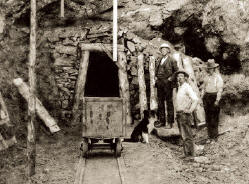
Entrance to the 50 meters long adit in1908. Note camp dog – Fritz. Photo courtesyof Collector’s Edge.
The Dallas operation of the minewent on until 1910. At that time operationsceased and the mine was abandoned.
Cover and color-plate from principal work about benitoites “Benitoite, its paragenesisand mode of occurrence” by G. Louderback, 1909. Courtesy of J. Veevaert.
Dallas, however, maintained theassessment work on the claim and wasable to patent the ground securing permanentcontrol over the deposit. Fromthen until the 1960’s the Dallas familyleased to the property to various operatorswho recovered specimens and gemrough. Perhaps most noteworthy of this group were Pete Bancroft and Ed Swobodawho visited the mine several timesbetween 1935 and 1938 collecting thousandsof specimens. In the 1930s it wasstill no small task to get to this remotelocation. In 1935 they set out to visit thedeposit after having been given directionsto the locality from their highschool teacher, Frank Gulick, who hadactively collected at the deposit the yearbefore in 1934. For an interesting view ofthe mine’s history, check out the interviewbetween Bancroft and Swoboda at:www.bluecapproductions.com/benitoite.
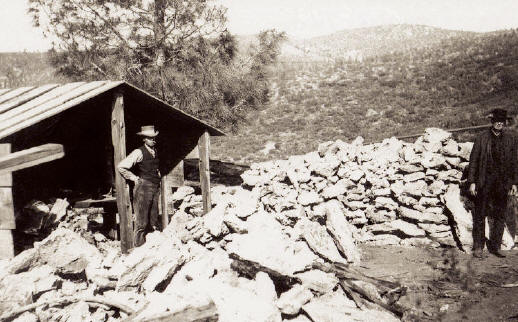
Stockpile of benitoite-rich natrolite veins at the mine in 1908. At this time etching ofspecimens was not use, and not many specimens survived mechanical preparation... Photo courtesy of Collector’s Edge.
From the 1940s until 1967 the depositwas leased by several people withvarying levels of production. Most notablyMiller Hotchkiss in 1952, ClarenceCole from 1953 to 1967, and JosephineScripps, sub-leased from Cole, in 1966.
Their efforts were modest in terms ofoverall production.
In 1967 Elvis “Buzz” Gray and BillForrest leased the property. They wereexperienced operators and set aboutto rehabilitate the mine site and developa logical mining plan for the deposit. Their efforts produced thousands ofgood specimens and considerable gemrough. It was also their effort to promotebenitoite as a gemstone that raised theawareness such that California designatedthe mineral as the official gemstoneof California in 1985. They boughtthe mine in 1987 from the Dallas family, and continued mining operations until2000.
Frequently seen at the mine wasFresno County Sheriff’s Deputy BobKahl. Bob was there to lend some securityto Bill and Buzz and also to help outas needed.

Stock certificate for 10 shares in the Dallas Mining Company dated on February 1907.
Courtesy of Collector’s Edge.
In 2001 Gray and Forrest soldthe mine to The Collector’s Edge of Denver,Colorado. Bryan Lees, the principalowner of the company, oversaw a completeand thorough mining of the remainingdeposit. He exposed the originalvein system and found that it had beencompletely worked out. His operationalso ran the entire dump materialthrough a custom jig system to separategem rough. He then set outto process the colluvial and eluvial materialthat had eroded from the originaldeposit over the millennia. A conveyorbelt also carried larger rocks off andeach, while wet, was visually inspectedfor specimen potential. His operationproduced many tons of specimen gradematerial and thousands of carats ofgem rough. The mine site was completelyrehabilitated according to SurfaceMining and Reclamation Act standardsin 2004.
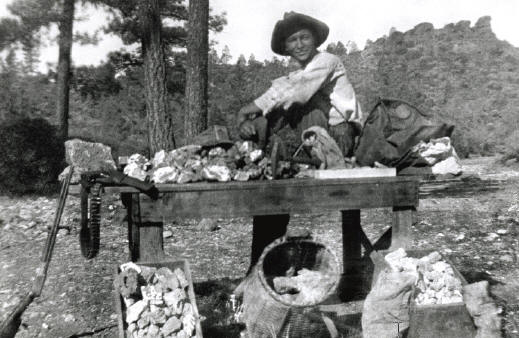
Peter Bancroft at the Dallas Gem mine in 1938 with stock of benitoite specimens. Photocourtesy of Ed Swoboda.
Bryan Lees sold the mine to DaveSchreiner of Coalinga in 2004. Dave wasdetermined to create a fee dig operationthere, but has been hindered withenvironmental regulations set by theEnvironmental Protection Agency andBureau of Land Management due tothe presence of naturally occurringasbestos. Reckless all-terrain vehicleand motorcycle operators over the last50 years have created enormous erosionalproblems as well, so the agenciesestablished a closure of the area to allvehicular traffic allowing access only toprivate property owners and valid claimholders. For the past several years Dave has been trucking material from themine to the Los Gatos Community parkjust outside of Coalinga and allowingpeople to screen the material for gemrough and specimen material. The opportunityto find specimen material or gem rough at the mine site does not currentlyexist unless groups access themine via the private chip sealed road. Even then, the previous mining efforts byCollector’s Edge left very little materialbehind.
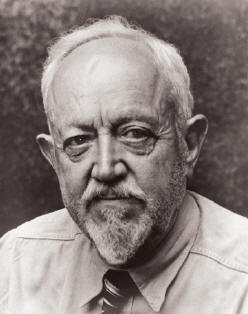
Professor George Louderback, mineralogist who did the original descriptive work on benitoites in 1907.



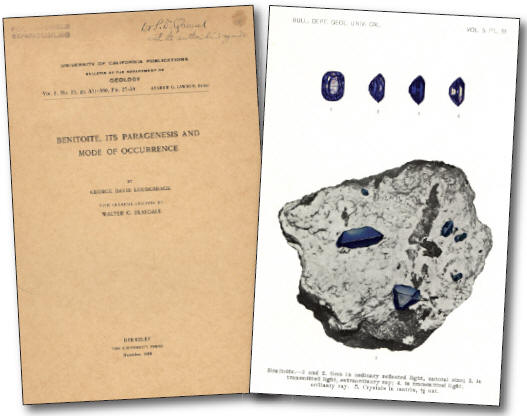




 YueGongAnBei 44051102000467
YueGongAnBei 44051102000467


 |
|